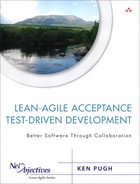Contents
The Importance of Acceptance Tests
Quick Feedback Better Than Slow Feedback
Control and Observation Points
Chapter 4. An Introductory Acceptance Test
Implementing the Acceptance Tests
Chapter 5. The Example Project
Chapter 6. The User Story Technique
Acceptance Tests Determine Size
Chapter 7. Collaborating on Scenarios
Chapter 10. User Story Breakup
Acceptance Tests Help Break Up Stories
Chapter 12. Development Review
Chapter 13. Simplification by Separation
Chapter 14. Separate View from Model
Chapter 15. Events, Responses, and States
Internal State or External Response
Transient or Persistent States
Chapter 16. Developer Acceptance Tests
Chapter 17. Decouple with Interfaces
Separating User Interface from Service
Chapter 18. Entities and Relationships
Chapter 19. Triads for Large Systems
When a Customer Test May Not Be Required
Chapter 20. Business Capabilities, Rules, and Value
Chapter 23. Using Tests for Other Things
Chapter 24. Context and Domain Language
Chapter 25. Retrospective and Perspective
Chapter 26. Case Study: Retirement Contributions
Chapter 27. Case Study: Signal Processing
Chapter 28. Case Study: A Library Print Server
Chapter 29. Case Study: Highly Available Platform
Chapter 30. How Does What You Do Fit with ATDD?
Chapter 32. Case Study: E-Mail Addresses
Requirements and Acceptance Tests
Documenting Requirements and Tests
Testing Systems with Random Events
Appendix B. Estimating Business Value
Appendix C. Test Framework Examples
User Interface Tests with Tables
